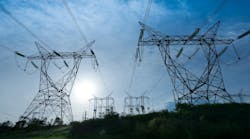Following the integration with transpower, TenneT is the first grid operator to use a special system to monitor overhead high‑voltage lines (220/380 kV) using real time meterological data to increase capacity of transmission lines. TenneT will present this system at the HUSUM Wind Energy 2010 trade fair. Furthermore, the first cross border TSO of Europe will present its five big offshore project in the German Northsea. TenneT is leading in Europe in connecting offshore wind farms.
More electricity thanks to wind‑cooled high‑voltage lines
The transmission capacity of overhead lines can be significantly increased – depending on the weather – by using this monitoring system. The distance from an overhead line to the ground and the maximum permissible temperature of the line impose a limit on its transmission capacity. Lines expand at higher temperatures. This makes them sag more and shortens the distance to the ground. A certain safe distance must always be maintained, however. When monitoring overhead high‑voltage lines, weather stations record the current ambient temperature and wind strength at the line. Using these meteorological data, the network control centre calculates in real time the dynamic loadability of the high‑voltage line. The calculated extra transmission capacity can then be used.
Transmission infrastructure modifications needed
The system requires complex calculations and expensive infrastructure modifications, especially in transformer substations. This is because all parts of the grid must be capable of withstanding the higher power loads. More than 900 km of high‑voltage lines and 20 transformer substations are going to be made suitable for the new system. This operation will cost approximately EUR 55 million. But the investment will be worthwhile: when strong winds occur, it will be possible to increase the transmission capacity of lines in northern Germany by up to no less than 50%. TenneT will introduce the monitoring system in its German high‑voltage grid as soon as the test phase has been completed successfully (scheduled for late 2010). The system will be used for lines subjected to exceptionally heavy loads because of the feeding in of wind energy and intensive usage.
An additional advantage of the system is that the higher transmission capacity of wind‑cooled high‑voltage lines will become available precisely at a time when a greater supply of wind energy pushes up the demand for transmission. Research is currently being carried out into the possibility of using the system in the Netherlands as well.

